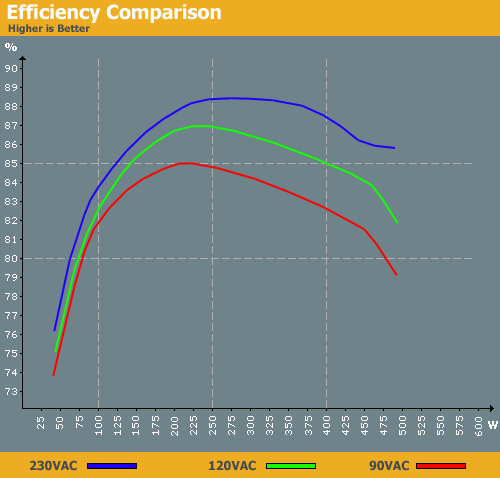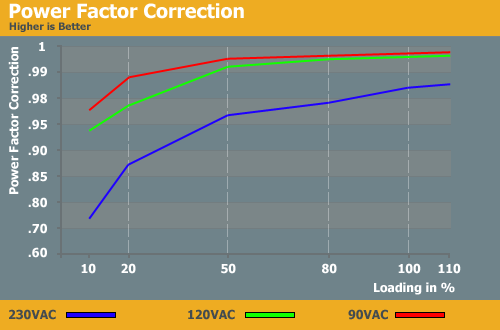Silverstone ST45NF Nightjar
by Christoph Katzer on August 25, 2008 1:00 AM EST- Posted in
- Cases/Cooling/PSUs
Efficiency, PFC and Temperatures


Using 230VAC, the Nightjar delivers efficiency of 88% from 225W to 375W. It then drops to 86%, which is still an excellent result. As the graph shows, the efficiency isn't as good with lower input voltages; optimal efficiency is obtained with loads of at least 100W, and the range of maximum efficiency is not the same as long as with 230VAC. Of course, even with loads of 50W to 75W it still manages at least 80% efficiency; while 88% might be more desirable, we are only talking about a difference of ~5W. What's the point in reaching 88% efficiency at 250W if you only need 50W?

The power factor correction looks good with lower input voltages, but we have seen much better results for 230VAC.

This unit does not have an exhaust temperature, which is why we attached the diode we normally use to measure the exhaust temperature to the power supply casing to measure the outside temperature. After loading the power supply for a while, we eventually reach a temperature that would allow us to cook an egg on the surface, but in fairness we have also seen hotter temperatures with some fan-cooled power supplies.
The outside surface reaches up to 58°C with 30°C ambient temperature. That's definitely not a bad result, and seeing the two heatsinks top out at 70°C makes us confident of its power supply's ability to run in systems with a single fan. However, temperatures are still increasing as we put an additional load on the PSU, and a higher ambient temperature would definitely result in higher PSU temperatures. We would be extremely hesitant to run such a power supply in a system where the ambient case temperature can reach 50°C or higher -- at least not without additional case fans, which defeats the purpose of the fanless power supply. Silverstone agrees with this, as they state the power supplies designed to operate in a 30°C ambient temperature.










20 Comments
View All Comments
JonnyDough - Tuesday, August 26, 2008 - link
See subject.Why do I want them to sell well?
Because more sales of high quality components = lower cost on great components due to economies of scale = better PSUs for everyone.
MLTodd - Monday, August 25, 2008 - link
The power supply looks great, but nightjar is another name for chamber pot, something that you urinate in at night in order to avoid the long cold walk to the outhouse. What was the marketing department thinking???aos007 - Saturday, September 6, 2008 - link
That was the first thing I thought about as well (chamber pot), and English even isn't my first language. On the other hand I have certainly never heard of a bird named Nightjar nor would I think a bird name is appropriate for a PSU anyway. Not sure why would anyone think only "history buffs" would know this. Does anyone read or go to museums any more? I thought schools are supposed to have mandatory reading materials to make you read classics and have school trips to learn about history. Do they teach anything in school these days?AmberClad - Monday, August 25, 2008 - link
Looking at Wikipedia, it's apparently a type of bird too. Which I didn't know until now -- I've always understood it to mean "chamberpot" as well. Surprisingly, Wiki doesn't have that definition...Being a Taiwanese company, one would assume that they're not familiar with the unsavory alternate meaning of the word.
strikeback03 - Monday, August 25, 2008 - link
When was the last time anyone who might be considering one of these used an outhouse, a chamberpot, or a nightjar? Other than history buffs, don't think many would know it isn't a bird or just a made up name.JarredWalton - Monday, August 25, 2008 - link
I actually thought it was a term for a chamber pot as well, but it seems very few places on the web still list that meaning. I was happy to know that there's a bird called a Nightjar, as that sort of makes the name sensible (inasmuch as naming a PSU after a bird can make sense).AmberClad - Monday, August 25, 2008 - link
Aha, so I'm far from the only person who immediately thought of a chamber pot when I saw that name. I actually went and Googled the term "night jar" too, and I was also surprised at the relatively few references to it being a piss pot (there were some though, so at least I knew I wasn't going crazy).Btw, have you guys mentioned this to the Silverstone people? I'm not sticking a nightjar into my case. Everytime I see that product name, I get unpleasant mental images that I can't get out of my head.
nubie - Monday, August 25, 2008 - link
I don't think it matters. Look at Nintendo and their "Wii Play" ads, if creepy men bringing their "Wii" over to play with your family doesn't hurt sales how will the merest hint of urine hurt a product practically no-one will notice?JonnyDough - Tuesday, August 26, 2008 - link
All the above comments make me wish AnandTech had a rating system on the comments. However, I've found that on sites like Tom's Hardware, the "authors" who never seem to preread their "work" (copying) before posting seem to rate each other up. Then they downrate anyone who opposes them. So I guess it's better if I just sit here and smile and agree in silence. Oops, I've said too much.emboss - Monday, August 25, 2008 - link
You're running the scope way too fast. The switching speeds of most modern PSUs is around 100 KHz, which means you want a timebase of ~10 us, give or take. At 40 ns, you're not going to see anything below a MHz or so, which is almost certainly going to be noise coming from outside the PSU (as opposed to PSU ripple). Also, if you're using AC coupling, make sure the cutoff frequency is well below the 100 KHz mark. One of the scopes I work with has a 250 KHz cutoff (-3 dB) when in AC coupling mode, which would hide any 100 KHz ripple.The main periodic signal in the traces you have is in the order of 100 MHz, and there's no way that's coming from inside the PSU.
Apart from that, good article :)